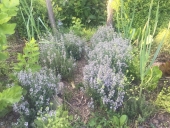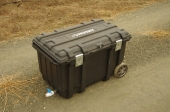
Hey permies folks!
We're back with a new blog post on
Bokashi Composting, part of our Nutrient Cycling for Homesteads series.
Earlier this week, we published the first part of the series, on
Vermicomposting- utilizing worms to break down some of the food waste we produce and turning it into a valuable garden soil. What about the food waste that worms DON’T like though - meat, dairy, bones, oils and fats, citrus rinds, etc.?
While we certainly can throw those in a homestead
compost pile (animal carcasses and fallen citrus certainly do decompose in nature), it isn’t recommended for a few reasons: animal products will attract other animals and can also introduce pathogens into your compost pile (remedied by either letting it rest for a year or two, or not putting it around your annual veggies), and citrus peels take a long time to break down - also remedied by letting it rest for a long while.
If you don’t want to deal with all that, but don’t want to resort to the trash can, there is another solution: Bokashi! Here is an outline of the info covered in the blog post.
Nutrient Cycling for the Homestead: Bokashi

Bokashi is an anaerobic method of fermenting organic wastes (i.e. pickling them) as opposed to typical aerobic thermophilic composting that decomposes organic material. Bokashi systems in this sense are more of a pre-composting method, as they do not yield finished soil, but instead microbially-rich fermented food wastes that are primed for incorporation directly into soil (or thermophilic compost piles, or vermicompost systems). And bokashi systems can handle juts about anything, save for perhaps gallons of used fry oil.
Also covered in the blog post:
The other reasons to do bokashi in your homeStep-by-step instructions on doing bokashi compostingHow to use “finished” bokashi pre-compostHow to make your own bokashi system and create your own inoculantLinks to some of the pre-fabbed systems available

Bokashi is yet another amazing technique to have as part of a homesteaders quiver for cycling food waste back into a usable garden product (even possible for apartment-dwellers who have a vermicompost system). It’s easy to get started - so please make sure to
check it out before you go, and please make sure to leave a comment to let us know how bokashi has worked for you if you’re already utilizing it, or share any questions you have!
With gratitude,
Wes and Casey

The 7th Generation Design “Nutrient Cycling for Homesteads” series covers the many ways you can build fertility, create soil, cycle nutrients and take responsibility for “waste” streams on your property. These systems all integrate with one another to increase resilience, improve nutrition (for soil and humans) and save dollars. The posts are written from our own experience and are geared towards the DIYer, though options are provided for ready-to-go purchased systems as well. For more of our blog posts, or our free e-books "Resilient Property Design Essentials", check us out at the link below!












